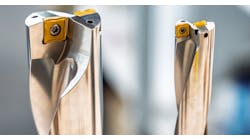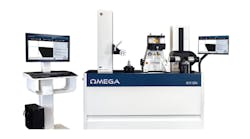A new finishing process significantly lengthens the life of cutting tools and other wear products.
Mikro 2100 strengthens cutting tools and provides a bright finish.
A look at a broach under a microscope shows the difference in surface finishes before (top) and after (bottom) being processed.
The MikroFinish process can be used on a number of different cutting tools, such as end mills, drill bits, and broaches.
The top image shows the edges of an untreated HSS tap. The same tap (bottom) has smoother edges after being treated by the Mikro 2100 process.
Some shops have a way to boost tool life by 10, making cutting tools stronger and smoother, capable of higher speeds and feeds, without changing their physical dimensions. Their secret? The Mikro 2100 finishing technology developed by MikroFinish Inc., Boonton, N.J.
Mikro 2100 is a mechanical process that reportedly improves the surface and subsurface of many materials. Besides strengthening parts, the process also provides a mirrorlike finish. MikroFinish is using it on a number of wear products, including human joint technologies, engine components, saw blades, and ball bearings. However, one of its most promising applications involves high speed steel and carbide cutting tools.
Strangely enough, says Steve Hoffman, chief technology officer, the technology originated as a way to polish optical elements for holographic systems. He developed what is essentially a lap-ping process that uses diamond or aluminum oxide to make fine scratch patterns, roughly 1 /20 of a micron deep. This process effectively polishes the optical lenses, which are about 14-in. wide and oddshaped.
Hoffman's next step was to speed up the process. That's when he devised a method of centrifugal agitation that multiplies G forces.
The process uses a simple concept: Basically, G forces multiply on objects as they are revolved. However, explains Hoffman, "The problem, of course, is that you can create fairly large G forces, but they're not dynamic — they're static. For example, think about clothes spinning in a washer. They don't move because G forces pin things away from the center."
Hoffman had to create a dynamic variation of G forces so that the media used in the lapping process could cascade across a surface. "We multiply the Gs to where no one had taken them before," he says. And when placed in a dynamic situation, small objects — in this case the size of dust — can dramatically smooth and harden material surfaces.
The process is proprietary, but Hoffman says the fine particles operate as if they were 1,000 their size and weight. Accelerated, they slide across a surface, creating a certain amount of pressure without deflecting the material and changing its shape. And unlike sandblasting or shot peening, the process does not physically change the metallurgy of the object.
When a cutting tool is placed in one of MikroFinish's machines, it is encompassed by a dry, environ-mentally friendly media applied with a precise universal high pressure between 25 and 1,000 G (most of the jobs are run at less than 100 G). All parts of the tool surface, including flutes and cutting edges, are compressed by cold plastic deformation, also called wear or strain hardening. "It's the same effect you get when you break in a new engine. If done properly, the product will last much longer," says Hoffman. The process also hardens a tool without changing its physical dimensions.
The Mikro 2100 process works by compressing the exterior surface of a material to mitigate what are called slip planes. "Slip planes are in every material," explains Hoffman. "To get an idea of what they are, visualize a brick wall. It usually cracks along a line that looks like a staircase. This fracture line is a slip plane." Compressing, or meshing, these relatively straight lines puts them into a "tongue-in-groove" relationship.
The physical improvement increases material hardness and generates a barrier that stops cracks. The depth of this change can be controlled for the best blend of hardness and ductile properties. "You usually want to work the exterior to make it harder and leave the interior ductile, so the material has the best of flexibility and strength to operate without brittleness," states Hoffman.
The Mikro 2100 process provides other performance benefits. It smoothes surfaces, optimizing lubricity and reducing friction. Hence, tools run cooler and don't bind up as often. The technology also improves the sharpened edge of the tool, even providing a selective honed edge if desired.
Up to the test
Currently, MikroFinish is a value-added manufacturer and direct marketer of the Mikro 2100 brand of industrial cutting tools. The company also treats other manufacturer's tools, turning them around in a day. In addition, tools that are processed can be reground at any point and, if the customer desires, returned for reprocessing.
In a head-to-head test, the Mikro 2100 tooling performed well against several brands of coated tools. According to Michael Demurjian, MikroFinish marketing director, "One of our customers plunge cuts brass/ aluminum with tools from other companies and averages between 2,600 and 2,800 cuts. The same customer stops our tool at 42,753."
Fargo Automation Inc., Fargo, N.D., has also taken advantage of the MikroFinish process. The company profiled and made pockets in an aluminum part using Garr
1 / 2-in., 4-flute micro-grain carbide end mills. Running the job at 40 in./min and 4,400 rpm, the company found that the untreated tool made a maximum of 110 parts, while the MikroFinish processed tool cut 650.
In another example, Forest Engineering, Forest Lake, Minn., tested Nachi 8.75-mm HSS jobbers length drills in 12L14 leaded steel. The unprocessed Nachi tool, which cost an estimated $3, drilled 3,000 holes; the Mikro-Finish processed one, which cost less than $10, made 15,000. This tool also compared favorably against three premium brand-name carbide drills. The best performance for these tools, which cost an estimated $15 to $30 dollars, was 10,000 holes.
Will it replace coatings?
Hoffman claims that the MikroFinish process has the potential to replace coatings in about 95% of the applications for which they are used. However, he says, coatings still provide benefits that his process can't. "One advantage involves lubrication. And in some cases, coating technology avoids a chemical inter-action between two materials." Coatings can also be used as a complimentary technology, according to Hoffman. "One of our customers uses our technology and then recoats the tool because of chemical interactions. The coating improves tool life by 3 , and our process multiplies that number another 3 ."
Other successes
Demurjian says that the MikroFinish process has a number of other applications besides cutting tools. It has been used on joint implants, heart valves, and ceramic hip replacements to improve surface finishes. "We're so precise that we are one of the preferred surfaces for medical implants and surgical tools. On ceramic heart valves, for instance, we can remove just one molecule of the surface."
The process has also cleaned up sockets blackened by heat treating operations. "In just 2 1 /2 min, the sockets looked like they had been chromed," says Demurjian. The process also strengthened the parts, taking them from 235 to 257 ft-lb.
According to Hoffman, "What's astonishing is that a fairly small change in the material makes a massive improvement in the application. Working with a 3 molecule thick surface layer, for example, we can improve life by 5 ."
Furthermore, he adds, "You get these benefits without redesigning anything. Right now, we're running race car components. We take wear points out of parts — like springs — that could crack under load and make an engine fail. And the engine runs equally or better on less energy."
Another benefit, points out Hoffman, is that MikroFinish treated metals don't rust as much as conventional metals do. "We found that something as simple as a smoother piece of metal rusts much less than a piece of metal with an abraded or irregular surface."
So far, the smallest part MikroFinish has processed was a government component that was less than 1-mm in diameter. The largest was a 6-ft-diameter boot for a jet engine. "We routinely handle parts up to 12-in. in diameter and lengths up to three or four feet," says Hoffman, "and we could build the equipment for even larger parts if






